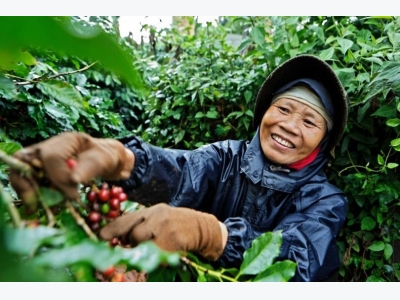Vietnam in gradual shift to exporting more roast and ground coffee

A decade ago most of the country's coffee exports were semi-processed beans.
The TNI King Coffee Factory that recently opened in Vietnam's southern province of Binh Duong is the latest player to join the race to ship more finished coffee products from the world's second-biggest producer.
With an investment of $15 million, the factory aims to produce 9,000 tons of roast and ground coffee and nearly 20,000 tons of instant coffee annually for export, according to Le Hoang Diep Thao, director of TNI Corporation and the co-founder of Trung Nguyen Coffee. She has also helped build five plants for Trung Nguyen, one of Vietnam's biggest coffee makers.
TNI Corporation, which has recently gained a foothold in China's online market for instant coffee and plans to start distribution through a supermarket chain there, did not give the size of its annual green bean demand for the new factory.
But to reach the targeted annual output, the Binh Duong-based facility will need at least 13,000 tons of green beans for roast and ground coffee and another 50,000 tons for the instant variety, according to a Vietnamese coffee expert at a European firm based in Ho Chi Minh City.
TNI's factory will have to compete with 200 plants already in operation or which which will be going into operation this year and the next, before the government puts a stop to new coffee processing plants in 2020 to ensure quality.
In December 2016, India's Tata Coffee said it will set up a freeze dried coffee plant in Vietnam to expand its market. In mid-January 2017, Tin Nghia Coffee Co began construction of a $28 million instant coffee plant in the southern province of Dong Nai, which is slated to open in early 2018.
Demand for raw materials from the new plants will eat into exportable green bean stocks in Vietnam, the world's largest exporter of semi-processed robusta beans, which has seen a smaller harvest this season due to adverse weather.
"Demand is rising about 10 percent a year, and with a higher ratio of bad-quality beans from the last harvest due to bad weather, Vietnam may face shortages in the third quarter," said the expert, who declined to be identified by name, referring to the three-month period starting this July.
Top exporter Intimex expects the supply crunch to emerge in May or June, citing Vietnam's fast export pace in the first months of 2017.
Smaller harvest
Vietnam's 2016/2017 output has dropped 8 percent to an estimated 26.7 million bags (1.6 million tons) due to high temperatures and dry conditions brought by El Nino, the U.S. Department of Agriculture (USDA) said in its December 2016 report. One bag contains 60 kilograms of beans.
Green coffee bean shipments are forecast to drop 13 percent from the previous 2015/2016 season to 23.5 million bags due to smaller output and more beans being used for domestic consumption or processed for export, the USDA said in its latest report.
As such, green beans accounted for 90 percent of Vietnam's total export volume, while roast and ground beans and instant coffee - or finished products - made up the rest. Vietnam's crop year lasts from October through September.
The forecasts mark a slow change to the country's coffee export structure. Five years ago, finished products made up only 2 percent of Vietnam's coffee shipments, the government said.
Exports of roast and ground beans in the current 2016/2017 season are projected at 550,000 bags, unchanged from 2015/2016, but above the 457,000 bags shipped in the 2014/2015 season, based on the USDA report. The forecast volume represents 2 percent of Vietnam's total projected shipments.
The USDA also forecasts instant coffee exports to remain steady at 2 million bags, which shows a surge of 56 percent from the 2014/2015 season, while it said domestic consumption of roast and ground coffee would rise nearly 10 percent from the previous season to 2.5 million bags.
Consumption of green beans in Vietnam is estimated at 2.87 million bags, up 9 percent from a year earlier, the USDA said.
Vietnam does not publish breakdowns for its coffee exports.
The Vietnamese government has plans to raise the output of roast, ground coffee and instant coffee to 25 percent of total output by 2020, while the output of instant coffee alone will increase to 5.83 million bags by 2030 from the 255,000 tons targeted for 2020.
Có thể bạn quan tâm
 Agricultural by-products: a billion-dollar 'gold mine' in Vietnam
Agricultural by-products: a billion-dollar 'gold mine' in Vietnam Agricultural by-products are called the "gold mine" of the Vietnam agricultural industry with up to 156 million tons per year. But these lucrative sources
 Longan distribution gets stuck, farmers suffer
Longan distribution gets stuck, farmers suffer Gardeners, farms and cooperatives need to sell 700 tons of longan a day, but collectors and distributors cannot access the growing areas because of Covid-19
 Farm produce exports - specialties reach new markets
Farm produce exports - specialties reach new markets Despite Covid-19, Vietnam’s farm produce exports still achieved impressive results, especially litchis.
 Vietnam to establish several hi-tech agricultural zones
Vietnam to establish several hi-tech agricultural zones Many hi-tech agricultural zones, as a result, have been established, making good use of advanced technologies like automatic, semi-automatic control, Big Data
 Vietnam aims to become world’s farm produce granary
Vietnam aims to become world’s farm produce granary The national digital transformation program says Vietnam will develop hi-technology agriculture with a focus on smart and precise agriculture